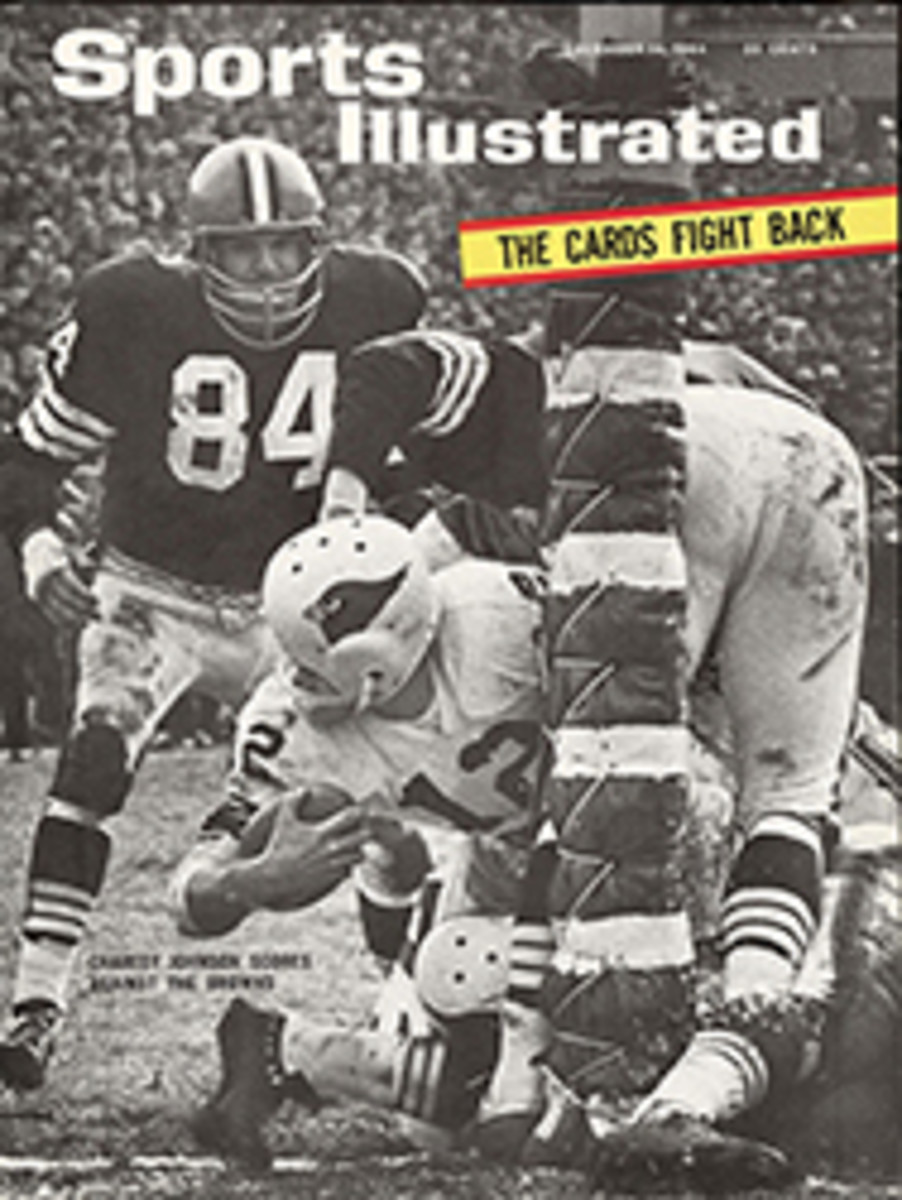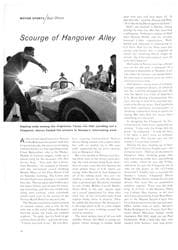
I REMEMBER LUCADELLO
One of the troubles with being a baseball fan is that it tends to ruin you culturally. Not that an intense interest in baseball means that you can't understand art or read good books or really appreciate music. You can enjoy the arts easily enough; the trouble is you can't talk about them. You don't know the names. Your cultural growth was smothered in the all-important learning years when teachers were tossing out Fragonard and Vivaldi and Henry Fielding and you were taking in—in my case—the batting order of the 1932 New York Yankees. Combs, Sewell, Ruth, Gehrig, Lazzeri, Dickey, Chapman, Crosetti...it comes back like remembered verse, if only I had had time in those days to memorize verse.
Through all of those impressionable years there was an extraordinary preoccupation with batting orders, batting averages, batting slumps, even bats themselves. The shape, color and surface texture of a brown Babe Ruth model bat is as vivid in my mind today as it was when Richie Schulz, I think it was, got one for his birthday 30 years ago. I have been in the museums on the Campidoglio in Rome and I remember the magnificent pieces of Greek and Roman art that I saw there, but not the way I remember that bat; it was a lovely bat.
If, at a cocktail party, someone were to bring up the 1934 Cardinals or the 1939 Dodgers (Durocher's first, you recall) or the 1931 Athletics, I could ease into the conversation effortlessly, appreciating what my companion had to say and adding enlightening bits and fragments of my own. But if the conversation falls on Paul Klee or that French painter named David whose first name I can't recall but who did a nice portrait of a girl sitting by a window in the sun wearing what looks like a nightgown, I choke a little. I tighten up. I don't honestly believe that the people I am listening to necessarily have any stronger feelings, one way or the other, about that David painting than I do, but they can talk about it a whole lot better. They know its name, and they know David's name. His first name. What do I know? I know that Bobo Newsom's real name was Louis and that his nickname was Buck before it was Bobo. See how far you'll get trying that on the next person who brings up Verlaine or poor, tortured Rimbaud at a party.
Nevertheless, there is hope for our lost generation, the one that thinks of St. Louis when the Browns are mentioned and Boston when people ask about the Braves. All we need do is adopt a gambit devised by my friend Giles Strafolino, who had what should have been an excellent education at a fine secondary school in Philadelphia and later at Amherst, except that he spent most of his time studying Line Drive Nelson and Herman Besse and other Philadelphia Athletics of the late '30s and early '40s. The gambit has been party-tested by Giles with amazing success.
Giles concluded, as I often have, that the talkers with all the right names at their fingertips were merely firing for effect and actually did not know much more about art or music, for instance, than he did. So he invented a few names. Now, at opportune moments, he drops them casually into the conversation with just enough impact to score points but not with such vigor as to invite questions. The names cannot be purely fictional; they have to be vaguely familiar to his listeners. He feels that very few cultured people (cultured in this case meaning knowing the right names, art-wise) know very much about baseball, because it is obvious to Giles from his own experience (and I, of course, back him all the way on this) that no one has time to learn both.
One evening over a martini he casually dropped the name of a good right-handed pitcher the Chicago Cubs had in the '40s. "Just the other day," he said, "I saw a rather attractive landscape by Claude Passeau in a little gallery in Greenwich Village." It worked, because he had gotten Passeau in and out of the conversation and had left his listeners in the little gallery in the Village, the location of which he could not quite remember. That is a vital part of the Strafolino technique; divert the attention of the bull, as they say in Spain. Let him see the man, but fix his mind on the cloth. Whole cloth, I suppose.
The technique prospered. Now, if Giles finds the talk has turned to music he might mention a Victor Red Seal record he picked up in a secondhand store of Lucadello singing arias from a Berardino opera—one of the early ones, he can't remember the name. This confession of partial ignorance is a marvelous camouflage. No one else can remember the early Berardino opera either, and naturally no one knows, as Strafolino does, that John Lucadello and Johnny Berardino were on the old St. Louis Browns together.
Following Strafolino's lead, I have developed my own bullpen of helpful names. Some I have not used yet, but others have put in quite a few innings. Of course, one trouble is, you start to get cocky. I mentioned one night that I had seen three fine marble busts by Portocarrero in a show window on the Via Condotti that were priced at only 100,000 lire each. I drew instant attention and the perfect reaction. Forgetting Portocarrero (Arnold, who last pitched for the Baltimore Orioles in 1960), someone, smug in his knowledge of the exchange value of the lira, said, "Why, that's only about $160 apiece."
But Portocarrero made me bold, and a little later I acted rashly. The conversation had turned to mosaic and then to inlaid wood and finally to the great Renaissance woodcarvers (Donatello was one, I believe, though to me it's Donatelli and he's an umpire whose first name is Augie). German names were bouncing around, and without thinking I said, "Did any of you ever see those interesting wooden altar pieces by Cletus Poffenberger?" It was an error. I had focused everybody's total attention on the name of the good Cletus, the Baron, Boots Poffenberger, one of the nuttiest and most colorful of the old Brooklyn Dodgers. Hurriedly I added, "I think they're in the Altkirche in Darmstadt. Or was it somewhere in Hesse?" That started them off on an argument about the old churches of Germany, and I escaped, but it was close.
Occasionally, I have tossed in a few Del Grecos, which is close enough to El Greco to be cheating, but Bobby was an artist in the outfield and I only use him as a throwaway. I am more forthright with Bissonette and Jacques Fournier of my French school (both were Brooklyn Dodger first basemen in the dim days hopefully beyond recall). And I am equally confident when, in discussing the Italians, I bring in Camilli the Elder; he was yet another Brooklyn first baseman, and his son, Camilli the Younger, who never paints much for me, is currently a Dodger catcher. Orsatti, a St. Louis Cardinal outfielder, comes in handy when discoursing on Italian wine. Dave DeBusschere, a Chicago White Sox pitcher, is another amusing little wine, but you have to be careful with a DeBusschere, since French wine connoisseurs are rather knowing and insatiably curious about an appellation they are not familiar with.
Modern art is a little tougher. I have gotten away with "a brilliant landscape by Mele, done almost entirely in burnt umber muted with peanut oil." Peanut oil turns attention away from Sam, a good outfielder and an unlucky manager. But again I almost came a cropper when I mentioned several abstractions by Edward Kranepool. I had forgotten that the Mets have become a cult almost as much as Jackson Pollock has and that the oddest people are aware that Ed Kranepool is their bonus-baby first baseman. I was much safer with a contemporary Italian sculptor named Antonelli (John pitched the New York Giants to a pennant in 1954) and in describing a humorous though rather satirical series of collages by Pappas (Milt of the Baltimore Orioles).
Music is fairly easy. I wasn't at all worried when I tossed in Schoendienst's Composition for Cello and Calliope, which I described as an experiment in dissonant harmonics. I had a little trouble getting out of the dissonant harmonic swamp, but none of my pursuers apparently had ever heard of Red, the incomparable second baseman. A Radatz symphony slipped by easily, at just about the time Dick was breaking the old American League record for appearances by a relief pitcher, and I felt so sure of myself when I got to talking about the Jimmy De Shong-Russ Van Atta musicals of the early 1930s that I had some of my listeners remembering the titles of their songs. None, however, remembered that De Shong and Van Atta had been American League pitchers from 1933 to 1939.
I have seldom needed to refer to literature, but I am ready. I want to cite some of the rare first editions I could lay my hands on if only I had the money—a copy of Pinson's Poems (Vada, of the Cincinnati Reds) and a wonderful leather-bound edition of Walberg's Life Of George Earnshaw. Earnshaw was a pretty famous pitcher in his day, the second man on the Athletics' staff after Lefty Grove, and I just might have trouble sneaking him by. But I doubt that any of the critics will know that Walberg, the redoubtable Rube, was the third man behind Grove and Earnshaw, and perhaps the juxtaposition of names will throw them off. If so, then I plan to praise the Modern Library for reprinting the Max Bishop translation of Louis Chiozza's short stories. Max was the second baseman who played behind Grove, Earnshaw and Walberg (their locker room was the Mermaid Tavern, as far as I'm concerned), and Lou Chiozza was a third baseman for the Giants who is best remembered for breaking his leg in the middle of the 1939 season.
I don't know how far I will push this. I have Orengo (Joe) on tap if we ever get onto Mexican painters and Heintzelman (Ken) for German composers. Any day now I plan to get the conversation around to Norwegian literature just so I can mention an obscure but profoundly influential 19th century novelist named Arndt Jorgens (who otherwise was only a second-string catcher on pennant-winning Yankee teams in the '30s).
And if I do that I will reward myself by saying to a passing waiter, who will be proffering a tray of drinks, "No, thanks. I'm a little tired of gin and tonic. Would you ask the bartender if he could make me a branch rickey?"
ILLUSTRATION
ILLUSTRATION
For pouring a fast ball past an intellectual, nothing rivals the name of this (hopefully) forgotten old Chicago Cub pitcher.
ILLUSTRATION
In art the author likes abstractions by Edward Kranepool, unless Met fans are near.
ILLUSTRATION
Antonelli, a contemporary Italian sculptor, once pitched the Giants to a pennant.
ILLUSTRATION
Schoendienst's "Composition for Cello" is a masterpiece of dissonant harmonics.

